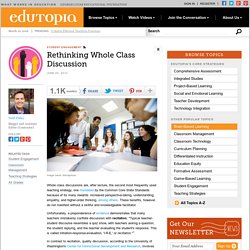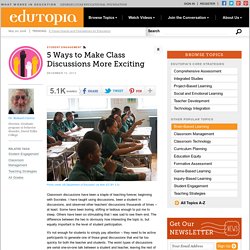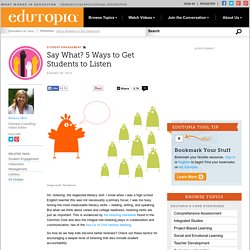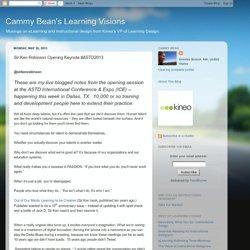

Mobile login. Learning Study. The Classroom Experiment (Ep.2) Storylinebloggen. Rethinking Whole Class Discussion. Whole class discussions are, after lecture, the second most frequently used teaching strategy, one mandated by the Common Core State Standards because of its many rewards: increased perspective-taking, understanding, empathy, and higher-order thinking, among others.

These benefits, however, do not manifest without a skillful and knowledgeable facilitator. Unfortunately, a preponderance of evidence demonstrates that many teachers mistakenly conflate discussion with recitation. "Typical teacher-student discourse resembles a quiz show, with teachers asking a question, the student replying, and the teacher evaluating the student's response. Time Management: Planning for the Adventure. Image credit: iStockphoto As we leave summer and approach back to school in a frenzy, the "To Do" list can become overwhelming.
As teachers, we find ourselves pulled in different directions -- setting up our classrooms, learning student profiles, meeting with parents, lesson planning, collaborating with administrators -- the list seems eternal! There is one important element that we sometimes forget: focus. In the words of Dave Burgess from Teach Like a Pirate , my favorite summer read, "Time is our most precious commodity, and it is definitely a finite resource.
" Teachers need to be reminded that, as much as we want to, we simply can't do it all. Think of planning for the school year as planning for an adventure. Prioritize Just as the possibilities on an adventure are endless, so are the tasks for your classroom. Make a List and Set a Timeline The brain of a teacher is rapidly firing with simultaneous tasks and concerns. The Teacher Brain. 5 Ways to Make Class Discussions More Exciting. Classroom discussions have been a staple of teaching forever, beginning with Socrates.

I have taught using discussions, been a student in discussions, and observed other teachers' discussions thousands of times -- at least. Some have been boring, stifling or tedious enough to put me to sleep. Others have been so stimulating that I was sad to see them end. The difference between the two is obviously how interesting the topic is, but equally important is the level of student participation. It's not enough for students to simply pay attention -- they need to be active participants to generate one of those great discussions that end far too quickly for both the teacher and students.
The best discussions keep everyone active, either by sharing or thinking. 1. Just the name "lightning round" suggests energy. 2. Say What? 5 Ways to Get Students to Listen. Ah, listening, the neglected literacy skill.

I know when I was a high school English teacher this was not necessarily a primary focus; I was too busy honing the more measurable literacy skills -- reading, writing, and speaking. But when we think about career and college readiness, listening skills are just as important. This is evidenced by the listening standards found in the Common Core and also the integral role listening plays in collaboration and communication, two of the four Cs of 21st century learning. 5 Powerful Questions Teachers Can Ask Students. My first year teaching a literacy coach came to observe my classroom.

After the students left, she commented on how I asked the whole class a question, would wait just a few seconds, and then answer it myself. "It's cute," she added. Lärares professionella lärande och utveckling - Helen Timperley. Sammanfattning-forskningsoversikten. Utvecklingssamtalet och den individuella utvecklingsplanen. Browse Talks. Sir Ken Robinson Opening Keynote #ASTD2013. @sirkenrobinson These are my live blogged notes from the opening session at the ASTD International Conference & Expo (ICE) -- happening this week in Dallas, TX. 10,000 or so training and development people here to extend their practice.

We all have deep talents, but it’s often the case that we don’t discover them. Human talent are like the world’s natural resources – they are often buried beneath the surface. And if you don’t go looking for them you’ll never find them. You need circumstances for talent to demonstrate themselves… Whether you actually discover your talents is another matter. Why don’t we discover what we’re good at? What really makes you a success is PASSION. Real world project. In a week from today, I will start my second teaching assignment at Queen’s School of Business: Integrated Marketing Communications.

Hey, I am excited, its going to be a lot of fun! Communications is an interesting course, no doubt, but that’s not the main reason for why I am looking forward to the next couple of weeks and months. The main reason is that I am the only instructor of this course (two sections). In other words: I have all liberties I could ever wish for to experiment with new course formats and teaching styles. Difference Between Projects and PBL. PBL and Languages. Editor's Note: Today's guest blogger is Don Doehla, French teacher and instructional coach at Vintage High School in Napa, California.

Don recently stepped up to become the new facilitator of our World Languages group. He's got some great ideas for teaching world languages, including the use of project-based learning. He shares a few of these tips today. We hope you'll join him in the World Languages group as well. The world may be small and flat, but it is also multilingual, multicultural, and more and more, it is an interconnected world. The Challenges Like other World Language teachers, I am constantly trying to focus on the essentials in order to create a standards-driven, communication-based curriculum for my students. PBL Checklist for Teachers. Web English Teacher. RubiStar Home.